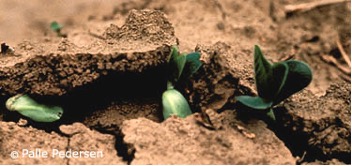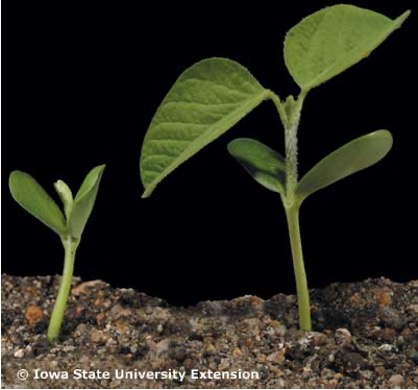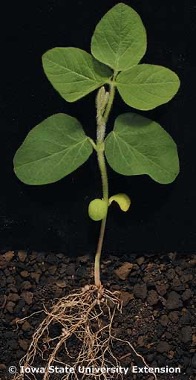Illinois grows the most bushels of soybeans of any state in the United States. The varieties we typically grow here are called “indeterminate” which means their pattern of growth can change as the season and conditions allow year to year. Staging soybeans is an important aspect to managing a healthy crop because many of our crop protection products have specific usage windows. Let’s walk through the stages and discuss crop protection considerations at each growth stage.
Preplant – This one is pretty self-explanatory. Preplant is the term used to describe a field of soybeans that has yet to be planted. This is the proper window to target burndown applications of weeds which may be present before planting. This is also a very good window for residual products to keep weeds from coming for several more weeks.
Pre-Emerge – This is the window after the planter goes across the field, but no part of the soybean has made it to the soil surface. Many of your residual herbicide options allow for applications three days after planting in this window. Usually when an herbicide calls for a cut off in application three days after planting, it is because the herbicide will destroy any soybean plant tissue it contacts. These herbicides do a great job applying a barrier to keep weeds at bay, but if pushed too close to emergence can cause quite the crop response.
VE or Emergence – VE officially begins when the cotyledons of the soybean seedling make it out of the ground.


Photo: Iowa State
Some herbicides can be applied during this timeframe, but for the most part, applications should be limited from now until the early vegetative stages.
VC or Cotelyedon – The plant pictured on the left is considered VE stage and the plant on the right is considered VC. The difference between the two, is the first set of singular leaves after the cotyledons have unrolled and opened. Those first singular leaves are called “unifoliate.” Again, at this stage we want to be careful of herbicide applications. The soybean plant does not have many growing points and if an herbicide damages a growing point, there may be a long road to recovery, if it ever does.

V (n) – Vegetative growth stages are counted by the number of trifoliate leaflets opened and unrolled.
For example, the plant pictured on the right would be considered “V1” because it has one trifoliate open and unrolled. Even though you can see the second developing towards the top of the plant, it is not unrolled and open yet, so it does not count for staging. This soybean plant would be considered “V4” because it has four trifoliate. The “V” stages are when you want to apply and finish up all your herbicide applications if possible. It is best to not apply anything which may adversely affect the reproductive growth of the soybean plant once it reaches the reproductive phases. One commonly overlooked piece of information is that Liberty or Glufosinate should stop by the time soybeans start flowering. You can do damage to your yield by applying late. It is important to watch your rotation restrictions with post herbicides as well. Flexstar, which is a very common herbicide in non-GMO soybeans, has a true 10-month rotation restriction to a corn crop planting.

R1 – This is the point in the crop’s life cycle they start focusing on reproductive phases. R1 officially begins when one single flower appears on the plant.
R2 – This is where almost all herbicide applications need to stop. Roundup and Enlist all say to apply no later than R2. R2 is also called “full flower,” and is characterized by flowers all the way to the top two nodes of the plant.
R3 – This stage, I feel, causes the most confusion. It is defined as having pods 3/16” long on one of the top four nodes. What makes it confusing, is that if there is a rain event, soybeans will usually take off growing again and add a few nodes technically putting the plant back into R2. R3 is significant because that is the peak timing of fungicide applications. I try to err on the earlier side of R3 and do not let the plant technically going backwards into R2 sway me to delay. In my opinion, the slowed respiration at this time helps to keep the maximum number of pods on the soybean plant.
R4 – At R4, you have pods ¾” long on the top four nodes. At this stage, you can still get response from fungicide, but the biggest return window is closing. It is important to watch for insect feeding at these later stages when maximum grain fill is occurring.
R5 – R5 is defined by 1/8” seeds in the top four nodes. Defoliation can be devastating at this growth stage. The plant is putting maximum photosynthesis into seed fill.
R6 – This stage is called “full seed.” Growth has reached its maximum for the year. The process of dry down has begun.
R7 – Beginning maturity, this stage is when one pod has reached mature color.
R8 – Full maturity, when all pods have made it to mature color.




 and then
and then